Kingfisher Provides Update on Drill Program at HWY 37 Project, Golden Triangle
Kingfisher Metals (OTCQB:KGFMF) has provided an update on its 7,500-meter drill program at the HWY 37 Project in British Columbia's Golden Triangle. The company has successfully extended potassic alteration with chalcopyrite and bornite mineralization approximately 150 meters below historical drilling limits at the Williams area.
Key drilling highlights include HW-25-004, which intersected intense potassic alteration over 478 meters, with bornite identified from surface to a vertical depth of 680 meters. The program has focused on testing depth extensions of the Williams porphyry Cu-Au system and exploring porphyry Cu-Au targets at Upper and Lower Hank areas.
The company is also conducting additional exploration activities, including an airborne electromagnetic survey (65% completed), induced polarization geophysics, and a soil sampling program that has collected over 750 samples.
Kingfisher Metals (OTCQB:KGFMF) ha fornito un aggiornamento sul suo programma di perforazione di 7.500 metri presso il progetto HWY 37 nel Triangolo d'Oro della British Columbia. L'azienda ha esteso con successo l'alterazione potassica con mineralizzazione di calcopirite e bornite a circa 150 metri sotto i limiti delle perforazioni storiche nell'area di Williams.
I principali risultati delle perforazioni includono il foro HW-25-004, che ha intercettato un'intensa alterazione potassica per oltre 478 metri, con la presenza di bornite identificata dalla superficie fino a una profondità verticale di 680 metri. Il programma si è concentrato sul test delle estensioni in profondità del sistema porfirico Cu-Au di Williams e sull'esplorazione di obiettivi porfirici Cu-Au nelle aree Upper e Lower Hank.
L'azienda sta inoltre conducendo ulteriori attività di esplorazione, tra cui un'indagine elettromagnetica aerea (completata al 65%), geofisica a polarizzazione indotta e un programma di campionamento del suolo che ha raccolto oltre 750 campioni.
Kingfisher Metals (OTCQB:KGFMF) ha proporcionado una actualización sobre su programa de perforación de 7,500 metros en el Proyecto HWY 37 en el Triángulo Dorado de Columbia Británica. La compañía ha extendido con éxito la alteración potásica con mineralización de calcopirita y bornita aproximadamente 150 metros por debajo de los límites históricos de perforación en el área de Williams.
Los aspectos destacados de la perforación incluyen el pozo HW-25-004, que intersectó una intensa alteración potásica a lo largo de 478 metros, con bornita identificada desde la superficie hasta una profundidad vertical de 680 metros. El programa se ha centrado en probar las extensiones en profundidad del sistema pórfido Cu-Au de Williams y en explorar objetivos pórfidos Cu-Au en las áreas Upper y Lower Hank.
La compañía también está realizando actividades adicionales de exploración, incluyendo una encuesta electromagnética aérea (65% completada), geofísica de polarización inducida y un programa de muestreo de suelo que ha recolectado más de 750 muestras.
Kingfisher Metals (OTCQB:KGFMF)는 브리티시컬럼비아의 골든 트라이앵글에 위치한 HWY 37 프로젝트에서 7,500미터 시추 프로그램에 대한 최신 정보를 제공했습니다. 회사는 윌리엄스 지역에서 기존 시추 한계선보다 약 150미터 아래에서 칼코파이라이트와 보나이트 광물화가 동반된 칼륨 변질대를 성공적으로 확장했습니다.
주요 시추 성과로는 HW-25-004가 있으며, 이 구멍은 478미터에 걸친 강한 칼륨 변질대를 관통했고, 표면부터 수직 깊이 680미터까지 보나이트가 확인되었습니다. 이번 프로그램은 윌리엄스 포피리 구리-금 시스템의 심부 연장과 Upper 및 Lower Hank 지역의 포피리 구리-금 목표 탐사를 중점적으로 진행하고 있습니다.
또한 회사는 항공 전자기 탐사(65% 완료), 유도 분극 지구물리학, 그리고 750개 이상의 토양 시료 채취 프로그램 등 추가 탐사 활동도 수행 중입니다.
Kingfisher Metals (OTCQB:KGFMF) a fourni une mise à jour sur son programme de forage de 7 500 mètres au projet HWY 37 dans le Triangle d'Or de la Colombie-Britannique. La société a réussi à étendre l'altération potassique avec une minéralisation de chalcopyrite et bornite à environ 150 mètres en dessous des limites de forage historiques dans la zone de Williams.
Les points forts du forage incluent le trou HW-25-004, qui a traversé une altération potassique intense sur 478 mètres, avec la présence de bornite identifiée de la surface jusqu'à une profondeur verticale de 680 mètres. Le programme s'est concentré sur le test des extensions en profondeur du système porphyrique Cu-Au de Williams et sur l'exploration des cibles porphyriques Cu-Au dans les zones Upper et Lower Hank.
La société mène également des activités d'exploration supplémentaires, notamment une enquête électromagnétique aéroportée (65 % achevée), une géophysique par polarisation induite et un programme d'échantillonnage des sols ayant permis de collecter plus de 750 échantillons.
Kingfisher Metals (OTCQB:KGFMF) hat ein Update zu seinem 7.500 Meter umfassenden Bohrprogramm im HWY 37 Projekt im Golden Triangle von British Columbia gegeben. Das Unternehmen hat erfolgreich die potassische Alteration mit Chalcopyrit- und Bornit-Mineralisierung etwa 150 Meter unterhalb der historischen Bohrgrenzen im Williams-Gebiet erweitert.
Wesentliche Bohrergebnisse umfassen HW-25-004, das eine intensive potassische Alteration über 478 Meter durchteufte, wobei Bornit von der Oberfläche bis zu einer vertikalen Tiefe von 680 Metern identifiziert wurde. Das Programm konzentriert sich auf die Tiefenerweiterung des Williams Porphyr-Cu-Au-Systems und die Erkundung von Porphyr-Cu-Au-Zielen in den Upper- und Lower-Hank-Gebieten.
Das Unternehmen führt zudem zusätzliche Explorationsaktivitäten durch, darunter eine luftgestützte elektromagnetische Vermessung (65% abgeschlossen), induzierte Polarisationsgeophysik und ein Bodenprobenprogramm, bei dem über 750 Proben gesammelt wurden.
- Extended mineralization 150m below historical drilling limits at Williams area
- Broad zone of intense potassic alteration discovered over 478m in HW-25-004
- Bornite mineralization confirmed from surface to 680m vertical depth
- Successful identification of two distinct porphyry intrusive phases, improving targeting
- Drilling difficulties caused HW-25-005 to be abandoned at 280m, short of planned 800m depth
- Significant drill hole deviation in HW-25-001 resulted in missing planned target
- Chargeability anomaly remains unexplained in certain areas
VANCOUVER, BC / ACCESS Newswire / July 31, 2025 / Kingfisher Metals Corp. (TSXV:KFR)(FSE:970)(OTCQB:KGFMF) ("Kingfisher" or the "Company") is pleased to provide an update on the previously announced 7,500-meter ("m") drill program at the HWY 37 Project. Drilling at Williams has extended potassic alteration with chalcopyrite and bornite mineralization by ~150 m below the limits of historical drilling. Bornite is mapped at surface and identified to a vertical depth of approximately 680 m in drill core. HW-25-004 intersected a broad zone of intense potassic alteration over 478 m. The 849 km 2 HWY 37 Project is located within the Golden Triangle, British Columbia.
Drilling to date has focused on testing for depth extensions of the Williams porphyry Cu-Au system, porphyry Cu-Au targets across the valley (east) in an area with no historical drilling, and at the Upper and Lower Hank porphyry Cu-Au targets (Fig. 1).
Dustin Perry, CEO, states "So far, the 2025 drill program has matched our expectations of vertically extending porphyry mineralization at Williams as well as providing a much clearer understanding of this highly prospective district. Our exploration hypothesis indicates vertical continuity of the gold-rich bornite zone, and these holes demonstrate that bornite continues to depth where it was predicted."
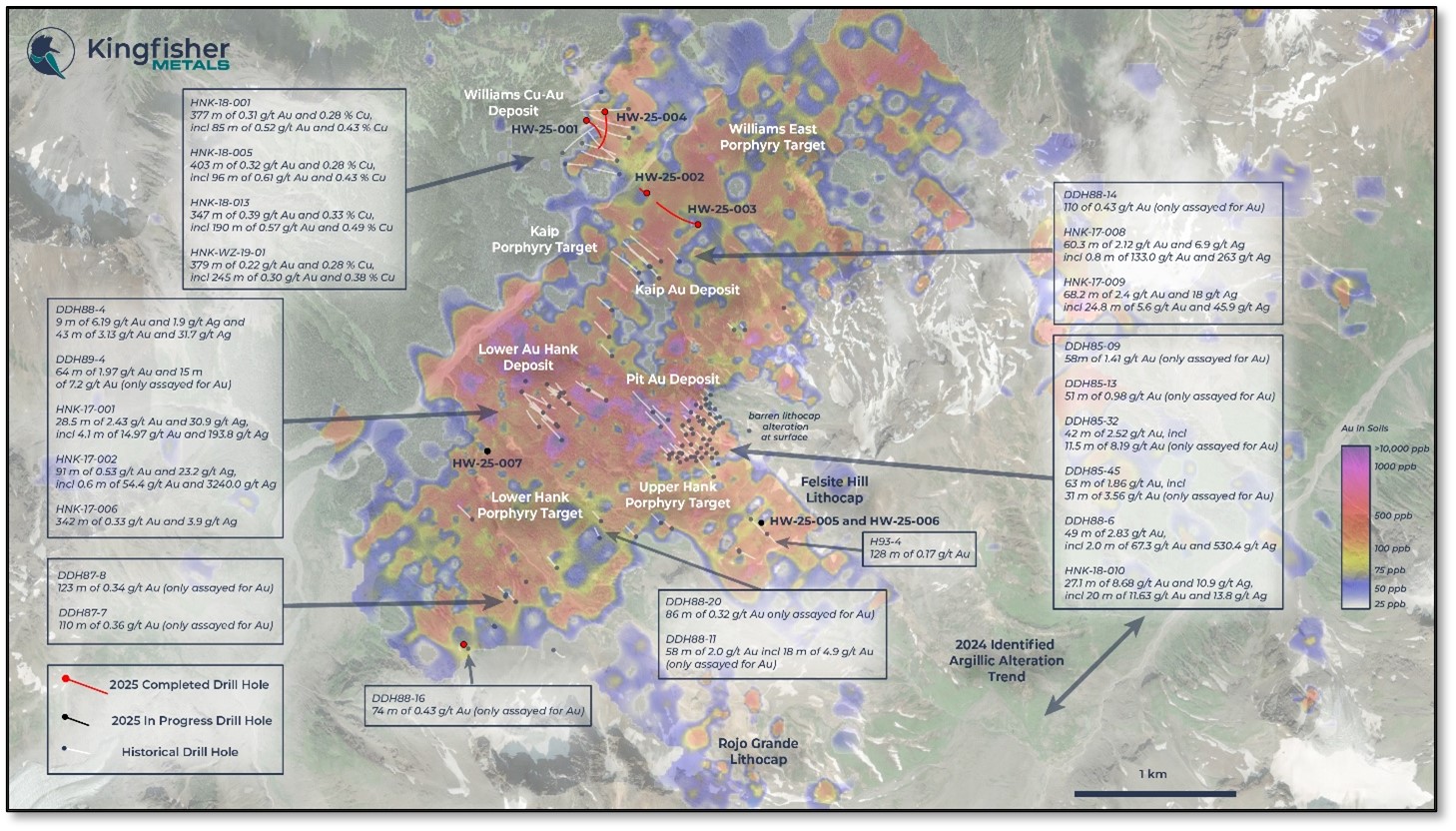
Figure 1: Hank-Williams Drill Area
Williams Area Drilling
The first drill hole of the program, HW-25-001, was completed upslope and west of potassic alteration and drilled steeply to the east. The drill hole was collared at a 110 o azimuth and -80 o dip, designed to test the western limit of the porphyry system and provide important data to define the orientation of the mineralized system at Willams. The drill struggled passing through several fault zones and deviated clockwise significantly more than historical drill holes in the region ending approximately 40 o azimuth from the planned target. Despite this, HW-25-001 intersected potassic alteration, often overprinted by phyllic alteration with chalcopyrite ± bornite mineralization from 390 m726 m (Fig. 2 and 3), end of hole was at 803 m and bottomed in early mineral monzanite. This drill test provided valuable insights to the mineralized system at Williams including identifying two porphyry intrusive phases that were previously lumped into one. The insights have improved Kingfisher's geoscience teams understanding of the mineralized system at Williams and allowed for better targeting of the younger more productive intrusive phase.
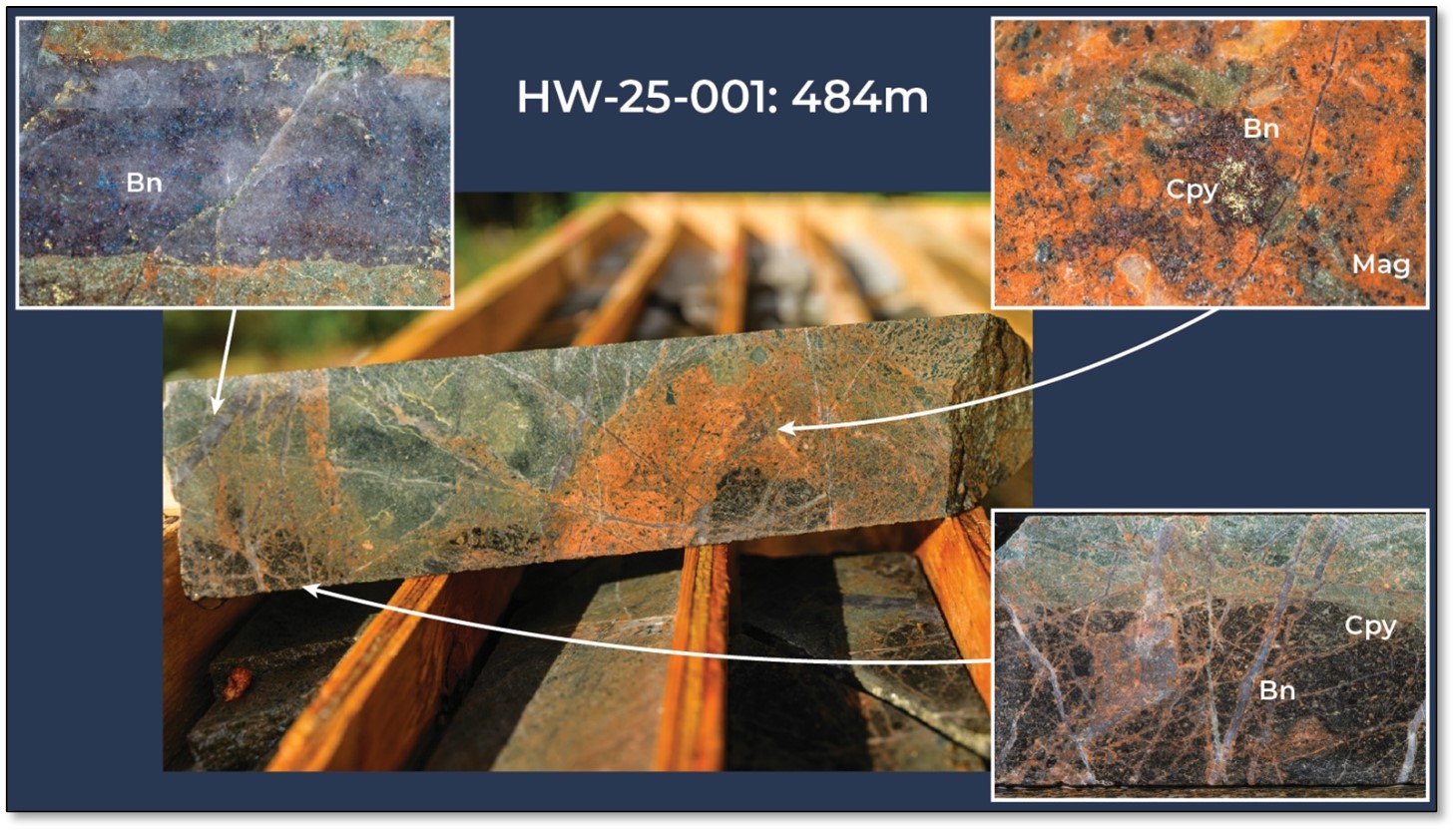
Figure 2: HW-25-001: 484m (Bn = Bornite, Cpy = Chalcopyrite, Mag = Magnetite) 1
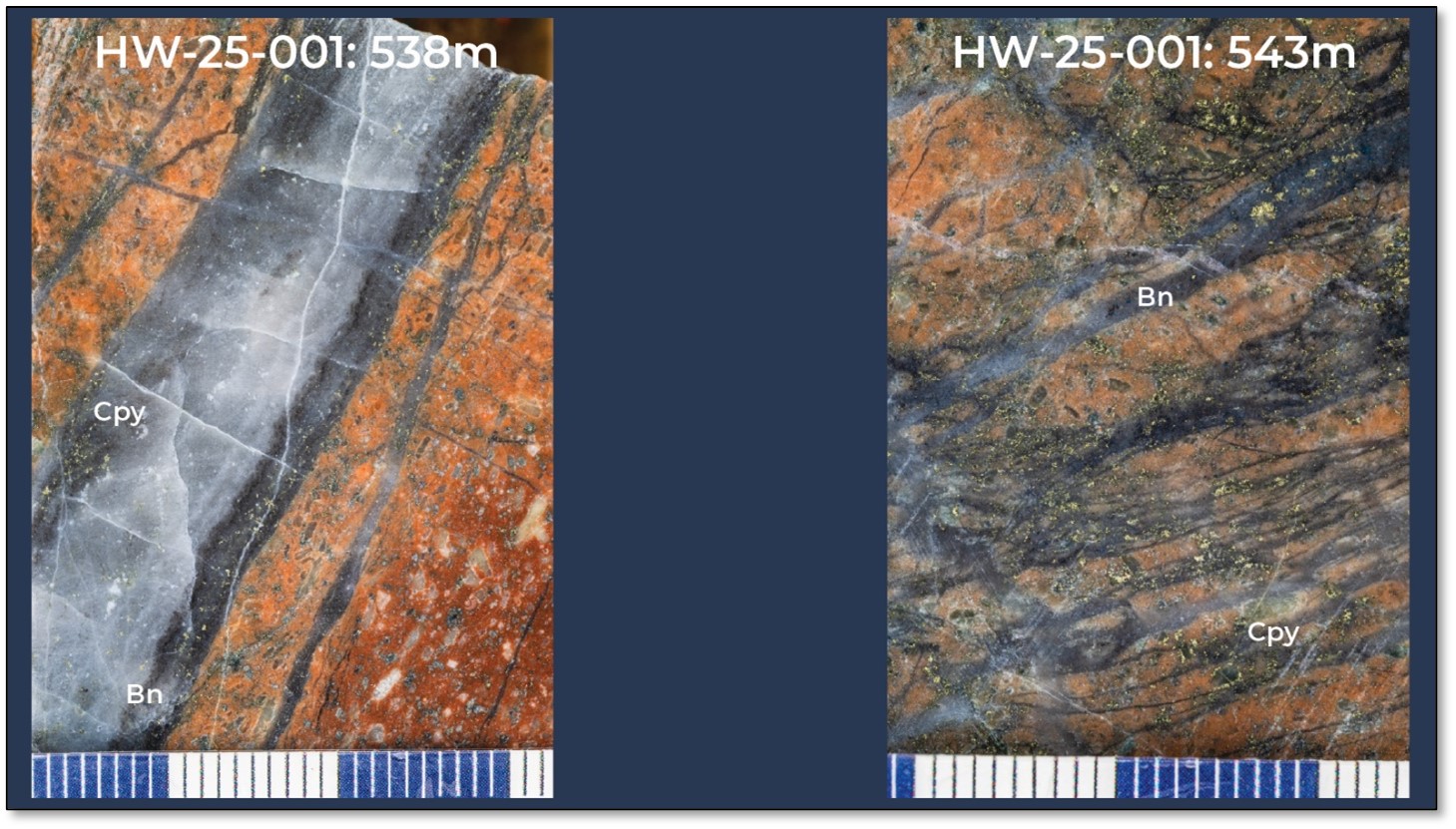
Figure 3: HW-25-001: 538m and 543m (Bn = Bornite, Cpy = Chalcopyrite) 1
Drill holes HW-25-002 (275 o /-60 o) and HW-25-003 (285 o /-68 o) were drilled across Hank Creek to the southeast and tested shallow chargeability anomalies that coalesce with the Williams porphyry chargeability signature at depth. Drilling in both holes encountered widespread intense quartz-sericite-pyrite-carbonate alteration in the top 250 m (HW-25-002) and 350 m (HW-25-003). Below this, it transitioned to a less altered, polyphase diatreme breccia which is interpreted to be emplaced before the mineralizing events at Williams (Fig 4). Diatreme breccias are commonly formed as an eruptive phase preceding or post-dating the formation of porphyry Cu-Au deposits. Surface mapping and drill results are interpreted to demonstrate high prospectivity for porphyry Cu-Au discovery at the margins of the diatreme breccia. It is believed that the Williams deposit, the Kaip target and the Williams East target (Fig. 1) are located at this boundary. At depth, the chargeability anomaly remains unexplained.
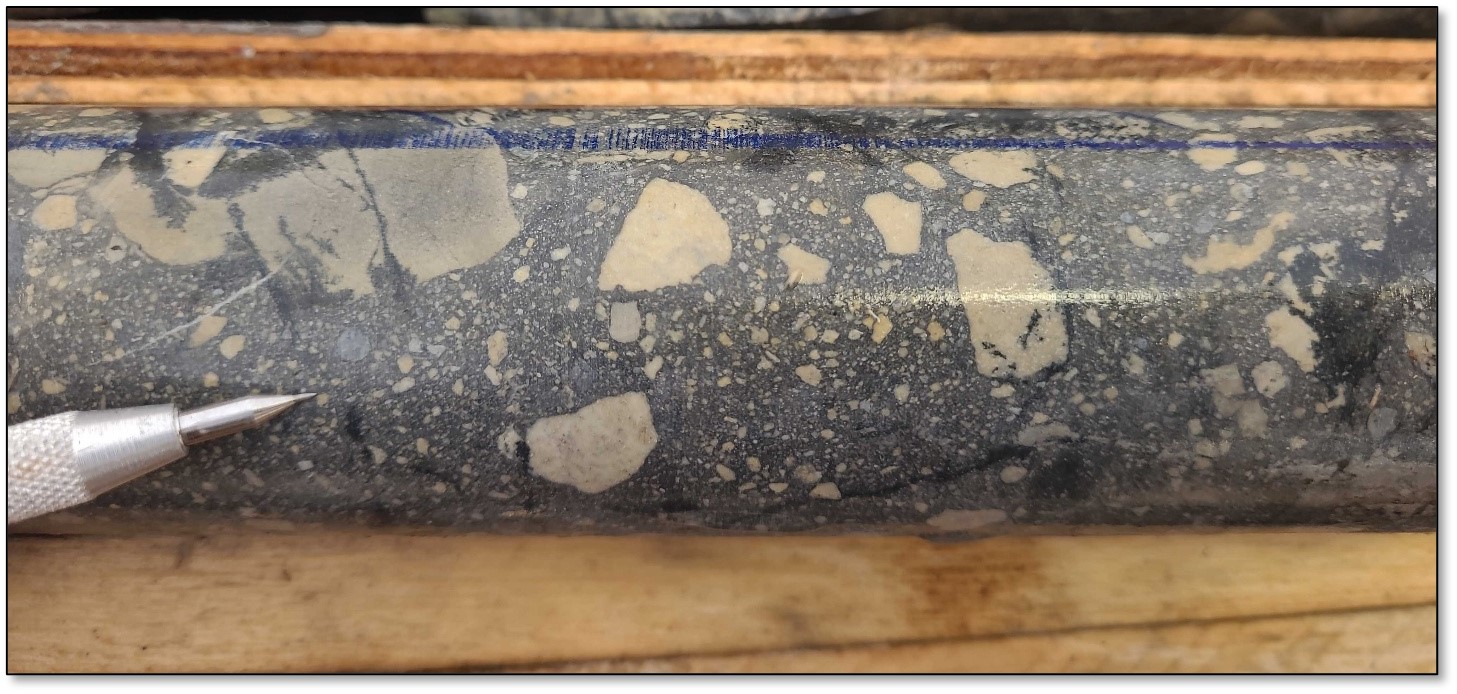
Figure 4: HW-25-002: 516m 1
HW-25-004 was collared at 174 o degrees and -76 o dip, upslope and north of potassic alteration at Williams. After passing through the Williams thrust fault at 327 m, the drill hole entered Cu-bearing potassic alteration. Intense potassic alteration with chalcopyrite-bornite mineralization (vein, stringer, disseminated, and blebby) was intersected from 327 to 805 m downhole and trace chalcopyrite to end of hole at 884.9 m (Figs. 5-8). Bornite occurs at surface (Fig. 9) at the discovery outcrop and has been intersected in drilling down to a vertical extent of 680 m. Strong potassic alteration comparable to what was noted in historical drill hole HNK-18-013 was intersected across this broad interval and extended visible copper mineralization ~150 m below historical drilling levels. Mineralization is open at depth and will be tested with additional drilling this field season.

Figure 5: HW-25-004: 411m, 422m, 532m, 673m (Bn = Bornite, Cpy = Chalcopyrite) 1
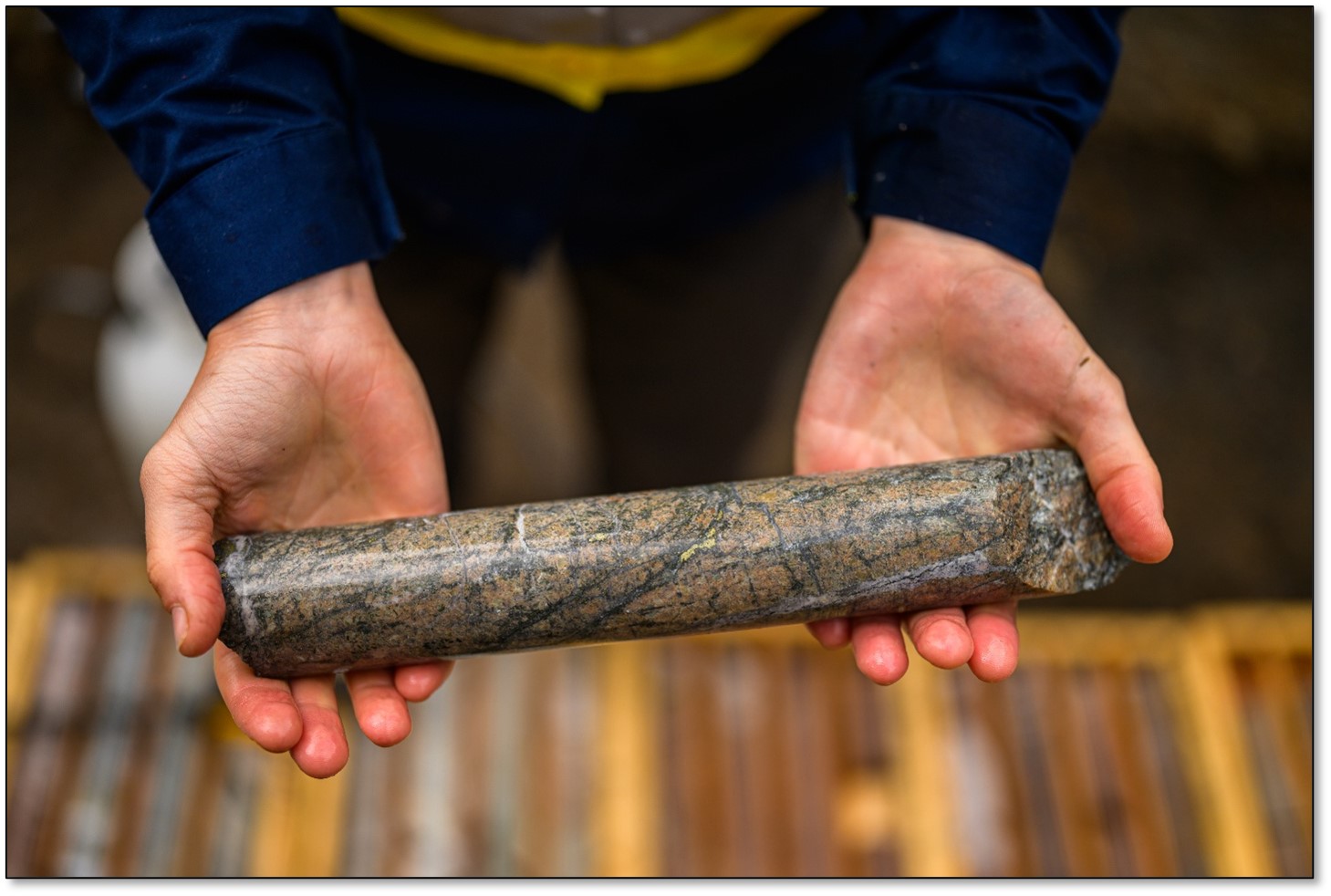
Figure 6: HW-25-004: 688m 1
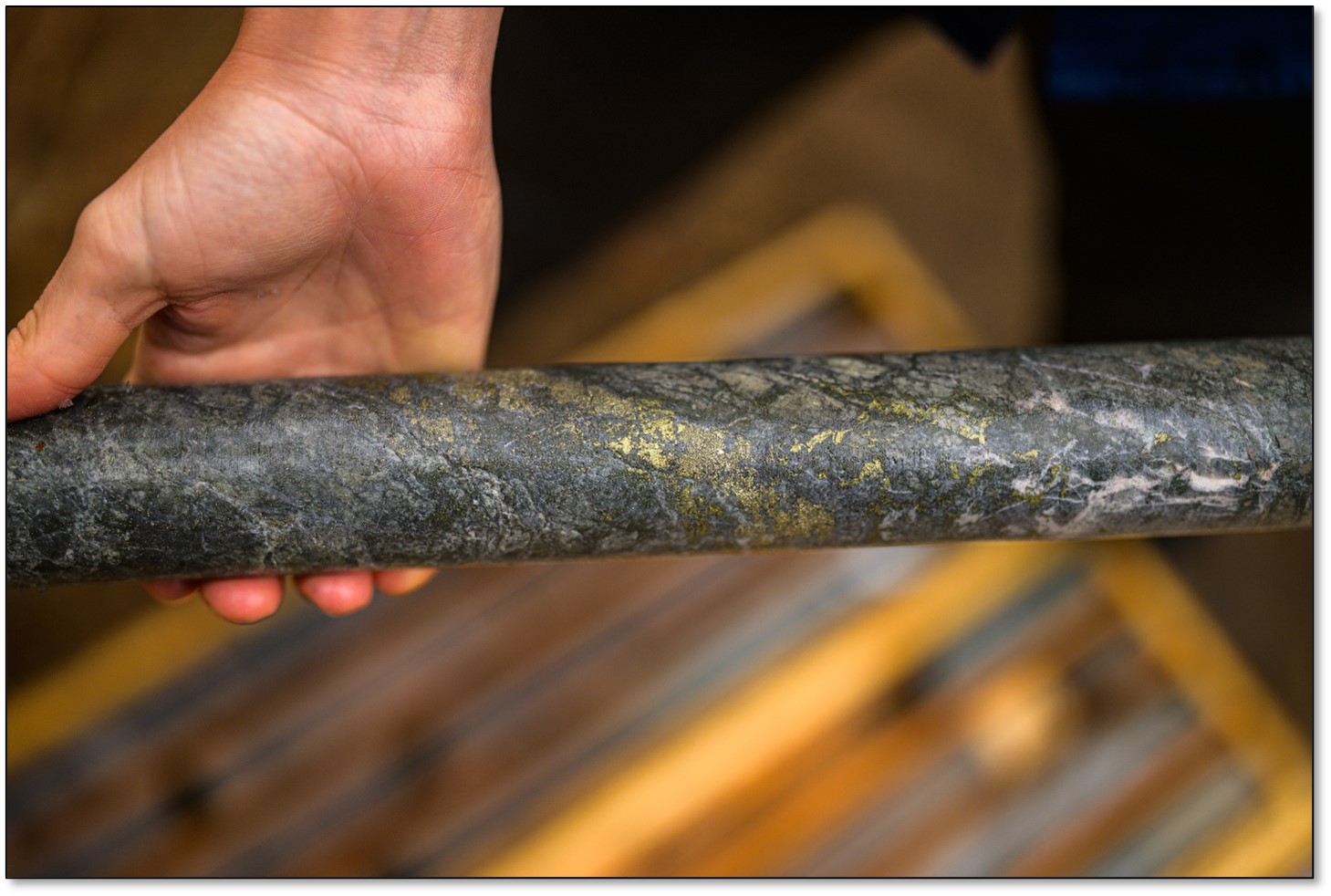
Figure 7: HW-25-004: 690m 1
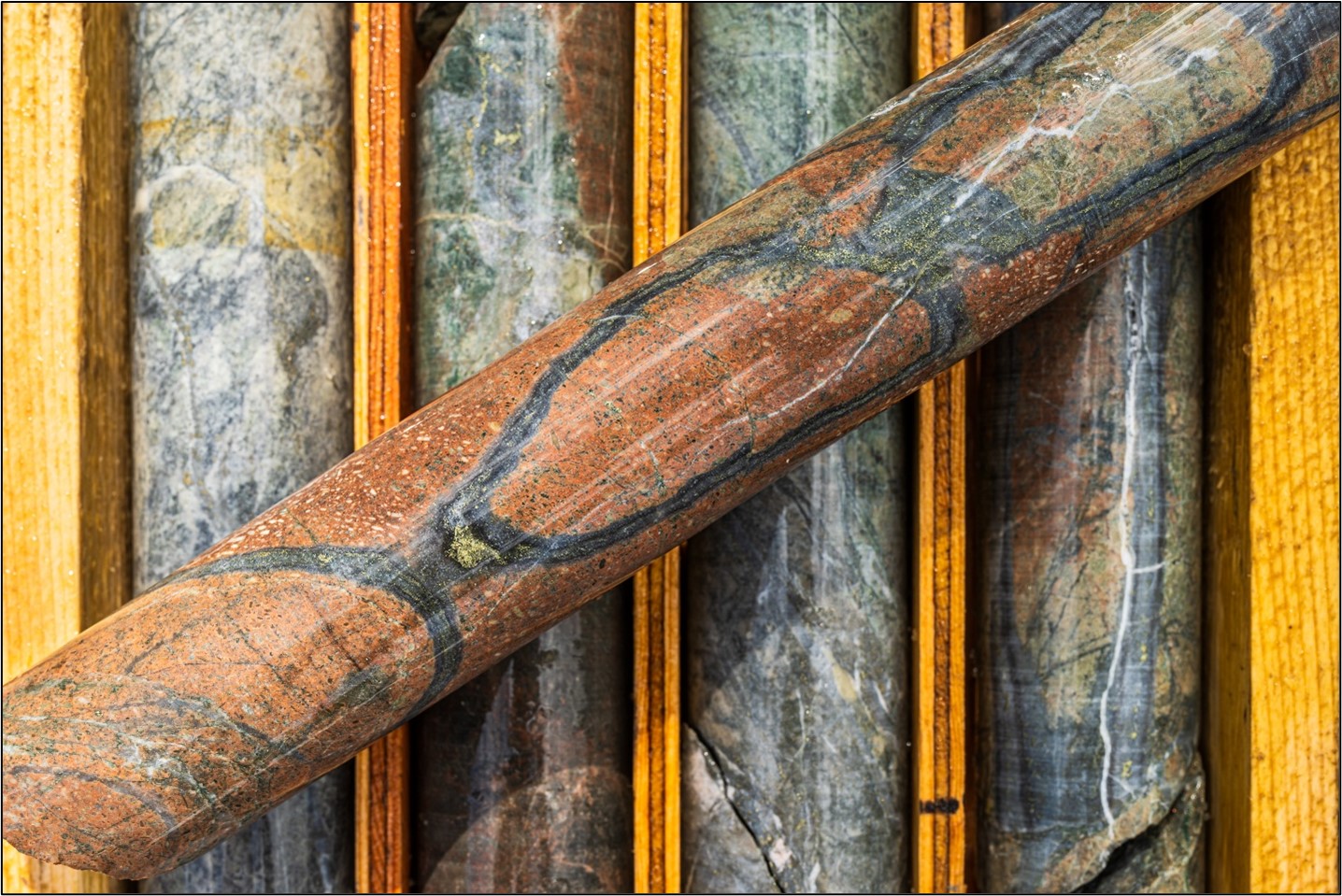
Figure 8: HW-25-004: 716m 1
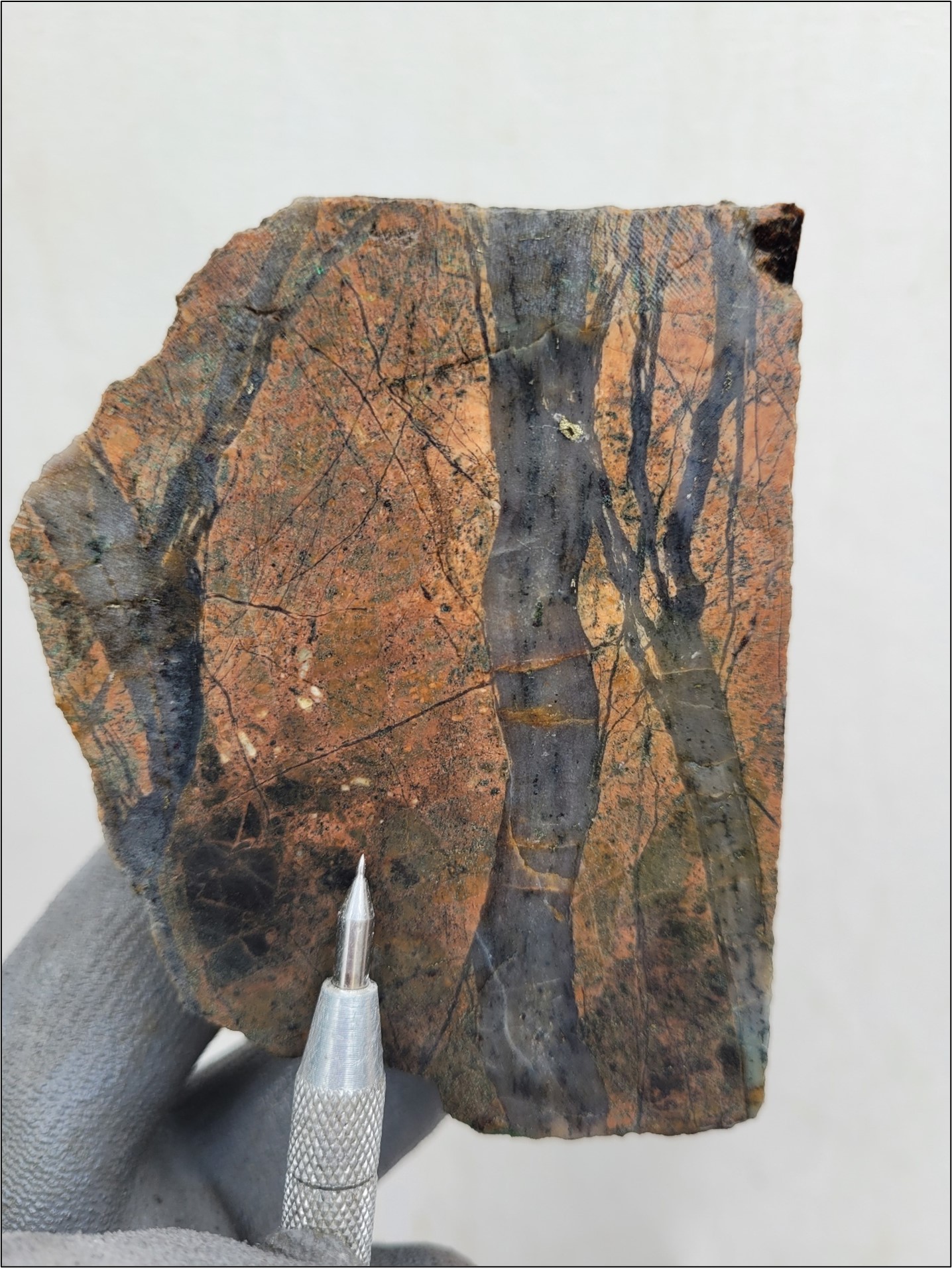
Figure 9: Surface Expression of Williams Porphyry Cu-Au System Containing Chalcopyrite and Bornite
Upper Hank Drilling
Hole HW-25-005 was collared at 275 o azimuth and -76 o dip and was targeting the Upper Hank Porphyry Target. This hole had to be abandoned before the planned depth of 800 m at 280 m due to drilling difficulties. This hole cut below the surface projection of a mapped polymictic, pyrite-rich breccia body. Two narrow porphyry intrusions were intersected accompanied by stringer veins of pyrite-magnetite-hematite and show similarities to intrusions observed at Williams. A new hole, HW-25-006 is a re-drill and is currently underway to test the chargeability anomaly target at depth below the pyrite-rich breccia.

Figure 10: HW-25-005: 197m 1
Lower Hank Drilling
Hole HW-25-007 is currently drilling at the Lower Hank Porphyry target with a collar azimuth of 174 o and a dip of -65 o . The hole is projected to intersect a steep quartz-sericite-pyrite-carbonate body mapped on surface (>
Regional Exploration Update
The airborne electromagnetic (MMT) survey is underway with approximately
Dr. Stephanie Sykora has been onsite for approximately two weeks. Her work has focused better understanding the controls on mineralization at the Williams area. Dr. Sykora's mapping campaign has been supported correlating the surface observations with detailed drill core logging. In the coming week Dr. Roy Greig and a team of mapping geologists from C.J. Greig & Associates will arrive on site to map several grassroots regions on the project.
Qualified Person
Dustin Perry P.Geo., Kingfisher's CEO, is the Company's Qualified Person as defined by National Instrument 43-101, Standards of Disclosure for Mineral Projects, and has prepared the technical information presented in this release.
About Kingfisher Metals Corp.
Kingfisher Metals Corp. (https://kingfishermetals.com/) is a Canadian based exploration company focused on copper-gold exploration in the Golden Triangle, British Columbia. Through outright purchases and option earn in agreements (Orogen Royalties and Golden Ridge Resources) the Company has quickly consolidated one of the largest land positions in the region at the contiguous 849 km 2 HWY 37 Project. Kingfisher also owns (
For further information, please contact:
Dustin Perry, P.Geo.
CEO and Director
Phone: +1 778 606 2507
E-Mail: info@kingfishermetals.com
Neither the TSX-V nor its Regulation Services Provider (as that term is defined in the policies of the TSX-V) accepts responsibility for the adequacy or accuracy of this release.
Cautionary Note Regarding Forward-Looking Statements
Mineralization hosted on adjacent and/or nearby properties is not necessarily indicative of mineralization hosted on the Company's property. This news release contains statements that constitute "forward-looking statements." Such forward-looking statements involve known and unknown risks, uncertainties and other factors that may cause the Company's actual results, performance or achievements, or developments to differ materially from the anticipated results, performance or achievements expressed or implied by such forward-looking statements. Forward-looking statements are statements that are not historical facts and are generally, but not always, identified by the words "expects," "plans," "anticipates," "believes," "intends," "estimates," "projects," "potential" and similar expressions, or that events or conditions "will," "would," "may," "could" or "should" occur.
Forward-looking statements in this news release include, among others, statements relating to expectations regarding the projects, and other statements that are not historical facts. By their nature, forward-looking statements involve known and unknown risks, uncertainties and other factors which may cause our actual results, performance or achievements, or other future events, to be materially different from any future results, performance or achievements expressed or implied by such forward-looking statements. Such factors and risks include, among others: the Company may require additional financing from time to time in order to continue its operations which may not be available when needed or on acceptable terms and conditions acceptable; compliance with extensive government regulation; domestic and foreign laws and regulations could adversely affect the Company's business and results of operations; the stock markets have experienced volatility that often has been unrelated to the performance of companies and these fluctuations may adversely affect the price of the Company's securities, regardless of its operating performance.
The forward-looking information contained in this news release represents the expectations of the Company as of the date of this news release and, accordingly, is subject to change after such date. Readers should not place undue importance on forward-looking information and should not rely upon this information as of any other date. The Company undertakes no obligation to update these forward-looking statements in the event that management's beliefs, estimates or opinions, or other factors, should change.
1 Examples of drill core photos are included to show the different styles of lithology, alteration, and mineralization, and are not necessarily representative of the entire lengths of specific intervals discussed within this release.
SOURCE: Kingfisher Metals Corp.
View the original press release on ACCESS Newswire







